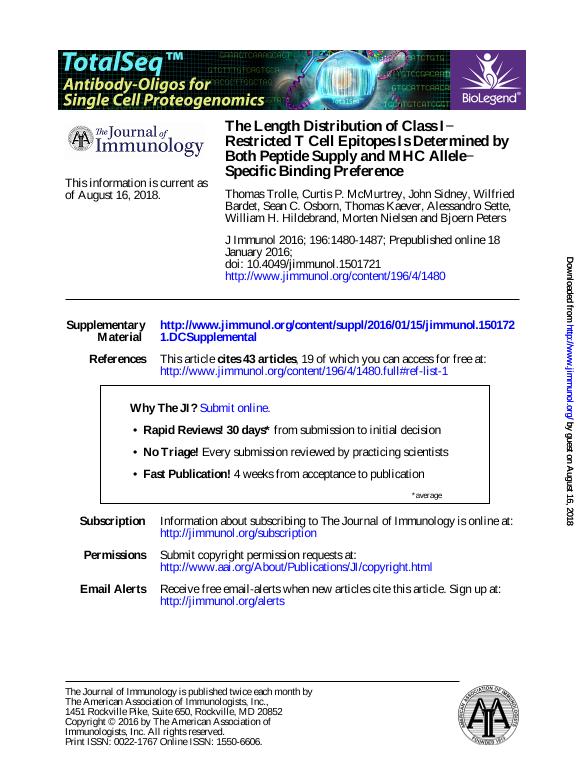Artículo
The length distribution of class I-restricted T cell epitopes is determined by both peptide supply and MHC allele-specific binding preference
Trolle, Thomas; McMurtrey, Curtis; Sidney, John; Bardet, Wilfried; Osborn, Sean C.; Kaever, Thomas; Sette, Alessandro; Hildebrand, Willliam H.; Nielsen, Morten ; Peters, Bjoern
; Peters, Bjoern
 ; Peters, Bjoern
; Peters, Bjoern
Fecha de publicación:
02/2016
Editorial:
American Association of Immunologists
Revista:
Journal of Immunology
ISSN:
0022-1767
Idioma:
Inglés
Tipo de recurso:
Artículo publicado
Clasificación temática:
Resumen
HLA class I-binding predictions are widely used to identify candidate peptide targets of human CD8+ T cell responses. Many such approaches focus exclusively on a limited range of peptide lengths, typically 9 aa and sometimes 9-10 aa, despite multiple examples of dominant epitopes of other lengths. In this study, we examined whether epitope predictions can be improved by incorporating the natural length distribution of HLA class I ligands. We found that, although different HLA alleles have diverse length-binding preferences, the length profiles of ligands that are naturally presented by these alleles are much more homogeneous. We hypothesized that this is due to a defined length profile of peptides available for HLA binding in the endoplasmic reticulum. Based on this, we created a model of HLA allele-specific ligand length profiles and demonstrate how this model, in combination with HLA-binding predictions, greatly improves comprehensive identification of CD8+ T cell epitopes.
Palabras clave:
Mhc Class I
,
Binding Motifs
Archivos asociados
Licencia
Identificadores
Colecciones
Articulos(IIB-INTECH)
Articulos de INST.DE INVEST.BIOTECNOLOGICAS - INSTITUTO TECNOLOGICO CHASCOMUS
Articulos de INST.DE INVEST.BIOTECNOLOGICAS - INSTITUTO TECNOLOGICO CHASCOMUS
Citación
Trolle, Thomas; McMurtrey, Curtis; Sidney, John; Bardet, Wilfried; Osborn, Sean C.; et al.; The length distribution of class I-restricted T cell epitopes is determined by both peptide supply and MHC allele-specific binding preference; American Association of Immunologists; Journal of Immunology; 196; 4; 2-2016; 1480-1487
Compartir
Altmétricas



